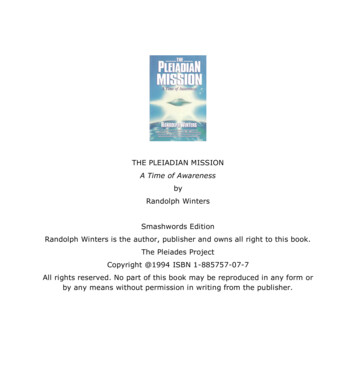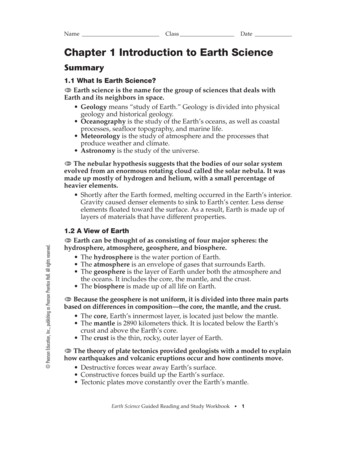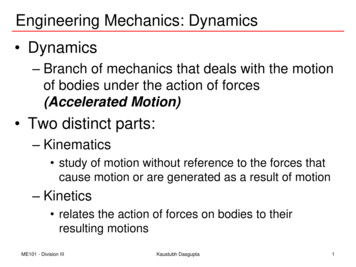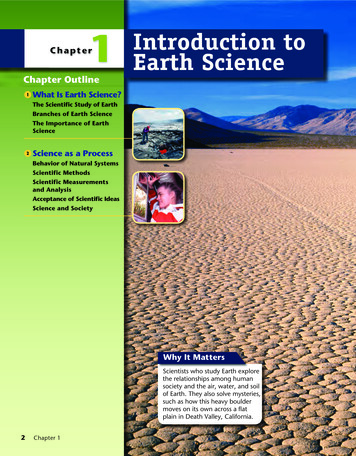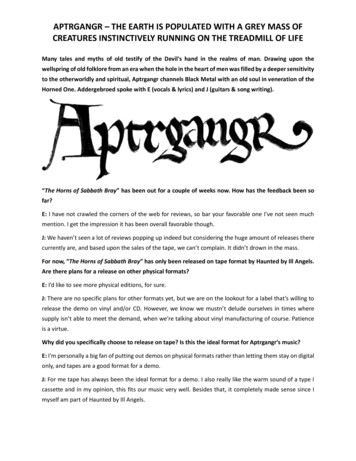
Transcription
APTRGANGR – THE EARTH IS POPULATED WITH A GREY MASS OFCREATURES INSTINCTIVELY RUNNING ON THE TREADMILL OF LIFEMany tales and myths of old testify of the Devil's hand in the realms of man. Drawing upon thewellspring of old folklore from an era when the hole in the heart of men was filled by a deeper sensitivityto the otherworldly and spiritual, Aptrgangr channels Black Metal with an old soul in veneration of theHorned One. Addergebroed spoke with E (vocals & lyrics) and J (guitars & song writing).“The Horns of Sabbath Bray” has been out for a couple of weeks now. How has the feedback been sofar?E: I have not crawled the corners of the web for reviews, so bar your favorable one I’ve not seen muchmention. I get the impression it has been overall favorable though.J: We haven’t seen a lot of reviews popping up indeed but considering the huge amount of releases therecurrently are, and based upon the sales of the tape, we can’t complain. It didn’t drown in the mass.For now, “The Horns of Sabbath Bray” has only been released on tape format by Haunted by Ill Angels.Are there plans for a release on other physical formats?E: I’d like to see more physical editions, for sure.J: There are no specific plans for other formats yet, but we are on the lookout for a label that’s willing torelease the demo on vinyl and/or CD. However, we know we mustn’t delude ourselves in times wheresupply isn’t able to meet the demand, when we’re talking about vinyl manufacturing of course. Patienceis a virtue.Why did you specifically choose to release on tape? Is this the ideal format for Aptrgangr’s music?E: I’m personally a big fan of putting out demos on physical formats rather than letting them stay on digitalonly, and tapes are a good format for a demo.J: For me tape has always been the ideal format for a demo. I also really like the warm sound of a type Icassette and in my opinion, this fits our music very well. Besides that, it completely made sense since Imyself am part of Haunted by Ill Angels.
APTRGANGR – THE EARTH IS POPULATED WITH A GREY MASS OFCREATURES INSTINCTIVELY RUNNING ON THE TREADMILL OF LIFEMany of the bands releasing on Haunted by Ill Angels seem to belong to a small circle of musicians,mostly based in Belgium. Aptrgangr, however, is a collaboration between two Belgian musicians andSwedish vocalist E. How did E. end up doing vocals for Aptrgangr?E: I’d been ordering some tapes from the label in the past, the Ish Kerioth, Paulus and Todesreigen tapesif memory serves, so I kept tabs on the label itself. Later I started an exchange with M from the label aboutliterature, and it was mentioned that J & P were working on something and were looking for a vocalist.Eventually it was suggested that I’d give it a shot, so I got in touch with them after hearing the recordingsand we started talking about concepts. The rest is history.J: We are indeed a rather small group of musicians, but it has never been the intention to limit the partiesinvolved. We are willing to collaborate with like-minded people, no matter where they’re from. ForAptrgangr, P and I had a clear vision musically and conceptually. We more or less had an idea what thevocals should sound like and started looking for the right vocalist. Initially we thought about possiblecandidates nearby, but none seemed fitting. In the end it was M who suggested we’d ask E. I’ve beenfollowing several of his bands quite closely for years and was already familiar with his style. After a firsttryout we were immediately convinced, both on a musical and on a personal level.
APTRGANGR – THE EARTH IS POPULATED WITH A GREY MASS OFCREATURES INSTINCTIVELY RUNNING ON THE TREADMILL OF LIFEAptrgangr refers to the ‘draugr’ or ‘draug’, an undead creature from the Scandinavian saga literature andfolktale that is some kind of ‘aptrganga’, literally “again-walker”. Was it E. who suggested the band nameand lyrical context, given the link with Scandinavian folklore?E: The lyrical concepts were discussed between the three of us – I think J & P might have already had aninkling of where they thought the concepts were going. The name was brainstormed, and I can’t recallwhich of us brought it forth.J: If I remember correctly, it was one of E’s suggestions. The initial idea was to base the lyrics on folk taleswe’re familiar with, on motifs that can be found in Belgium and adjoining Western European cultures. HadE not agreed to work with us, we certainly wouldn’t have chosen a Scandinavian band name.“Aptrgangr” actually refers to the haunting, the walking again itself rather than the revenant responsiblefor it. It’s an Old Norse term, of course, but it doesn’t necessarily refer to a phenomenon that’s unique toScandinavian folklore. Revenants in one form or another are common in a myriad of stories from differentcultures all over the world.Example of a draugen by Theodor Kittelsen - Sjøtrollet, 1887 (The Sea Troll)
APTRGANGR – THE EARTH IS POPULATED WITH A GREY MASS OFCREATURES INSTINCTIVELY RUNNING ON THE TREADMILL OF LIFEThe ‘draugr’ often appeared in Icelandic folk literature. Why did you specifically choose to name theband after this creature and not one that is more common in Swedish or Belgian folk tales?E: Draug/Draugr isn’t unique to the Icelandic folklore but originates from Old Norse (which of course isrelated and perhaps most closely akin to modern Icelandic) – so to me it makes sense.J: It does indeed. There are more Icelandic than other Scandinavian manuscripts – most of the latter havenot been preserved – but considering that Scandinavian settlers arrived in Iceland only around 1200 yearsago while folk tales are usually much older, it’s a given that they all had (and still have) a lot in common.Motifs may have evolved in different directions during the centuries to follow, but in their core, they are ashared Scandinavian heritage and not limited to only Sweden or Iceland.Besides that – like stated earlier – the concept of a draugr or revenant is not limited to Scandinavianfolklore. A lot of traditional local folk tales talk about the deceased roaming the earth looking forredemption and trying to make their way to the afterlife or, in more contemporary tales, haunting thephysical plane and often even wanting to do harm.Do the ‘draugr’ still live on in modern day life, music, art, literature, .?E: I would say the literal meaning is nothing more than stories of old. The idea of revenants in the spiritualplane is another far more interesting one. You could say however that the world is full of living dead, husksof flesh that wander aimlessly with no soul or greater connection to the Other. The glory of the digital age.J: I agree, the earth is populated with a grey mass of creatures instinctively running on the treadmill of life.However, the difference with the revenants of the old tales is that the modern ones have no real purposebut a hopeless pursuit of the modern society’s acknowledgment. A rather empty non-existence if you may.I have absolutely no clue what the album titleis referring to, so please enlighten me!E: The title is lifted from a line in the title trackthat speaks of the witch flight to Brocken peak,to celebrate the Sabbath with the Master andHis hellish host. The track deals with the conceptof the Wild Hunt as a precursor to the travel tothe Sabbath, and as such the horns of the Huntsound to signal the start of the hunt, but at theSabbath they sound to signal the feast andveneration of the Devil and his court.Representation of Brocken witches flying toBlocksberg on an illustration by LS Bestehorn (1732)
APTRGANGR – THE EARTH IS POPULATED WITH A GREY MASS OFCREATURES INSTINCTIVELY RUNNING ON THE TREADMILL OF LIFEHow is the album title related to the beautiful painting that was used for the album cover?J: The painting we decided on is a study Luis Ricardo Falero did for his “Witches going to the Sabbath”, soit kind of picks up where the title track left off. While the final painting is very detailed, well-executed andbeautiful, we thought the raw energy of the study was more fitting in the context of our music. Itscrudeness also goes better with the idea of medieval devilry which is, of course, reflected in the lyrics, butalso in the calligraphy (based on old manuscripts) we used for both our logo and the demo’s title and tracklist.The lyrics draw upon the wellspring of old folklore froman era when the hole in the heart of men was not filledby screens but by a deeper sensitivity to the otherworldlyand spiritual. Do you consider yourselves spiritualbeings? If so, in what way(s) does spirituality have a placein your everyday life and this rat-race called life?E: I can’t speak for the others, but yes, I consider myself aspiritual person. Obviously that tag has a wideinterpretation, so I’m not sure we even have the samedefinition, but I accept and believe in something beyondthe physical realm and that some of these things may havean impact on the physical realm as well. In everyday life Ithink as with anything it is present, but its intensitycertainly varies depending on a lot of factors. Has it alteredmy life in any way? I can’t say for certain, but I believe so.Also, to me at least the practice of art is an almost spiritual act. Channelling whatever impulses that yourmind picks up and forming these into something – whether that be painting, poetry, music, lyrical content,performance art or other expressions that seek to assail the senses of others – I consider this a veryspiritual act that may impact others.J: It is most definitely a very personal thing. I don’t think of myself as a spiritual person in terms of religionbut perhaps more in relation to nature and some personal form of self-transcendence. I am not lookingnor striving to achieve a greater purpose as an indispensable actor in the greater scheme of things.Because, in my opinion, there is none really. On the other hand, who am I to dispose of such ideas? I am,however, definitely and constantly striving for self-enrichment in a non-materialistic way. One mightconsider this or at least parts of it to be a spiritual act. And like E stated earlier, it’s hard to deny or lookpast the spirituality in the practice of art.
APTRGANGR – THE EARTH IS POPULATED WITH A GREY MASS OFCREATURES INSTINCTIVELY RUNNING ON THE TREADMILL OF LIFEIn the Western Christian and Jewish tradition, the Devil has entered popular folklore, particularly in hisrole as a trickster figure. He is found as a character in many traditional folktales and legends where heoften attempts to trick or outwit other characters. What are some of your favourite local folk tales (bothBelgian and Swedish) wherein the devil – in one way or another – plays a significant role?E: So Swedish folk tales are often quite short, and there’s several of them that are variations on othercultures’ folklore which I guess is a natural thing. “Prins Hatt Under Jorden” is one of those that has anarrative close to some of the Greek myths about Orpheus. One other that I recall from my childhood isthe one about a boy who competes with a giant in eating and cheats to not end up being food himself. Wehad a book in my home called just “Folk Tales” which was one of a series of seven books in total thatgathered folk tales from all over the world. One of these has fantastic illustrations by Hans Arnold andsome of those are great as well – “The Troll on the Island by the Sea” from Iceland, which is a very Hansel& Gretel-like tale. The seventh book is more themed and contains several very short tales relating tovarious beings from folklore and this has a specific one with the Devil as the antagonist – one good one iswhere the Devil appears to punish a noblewoman, “Pintorparfrun”. Otherwise it is also easy to see a lot ofthese other beings as manifestations of the Devil – trolls, sirens, hobgoblins and others were very muchviewed as servants of the Horned One back then.J: There are a lot of local folk tales in which thedevil is mentioned. Most of these are alsovariations on other classic Western Europeantales. The local devil tales often have a veryrural character, which I enjoy quite a bit. Forinstance, the devil’s barn, where the devil isoutwitted by the supplicant. Or the storiesabout theshepherds/exorcists, like theshepherd from Arbrefontaine (Liège), whodabbled in (black) magic and was in possessionof magical grimoires. The stories about theGerman shepherds, common in West Flanders,of whom is believed that they possessed magicpowers granted by the devil. In the southernThe Devil’s Barnpart of Belgium there are also lot of classictales in which a poor farmer calls upon the devil for help, quite often it’s the farmer’s wife who preventsthe devil from succeeding. One of my favourite tales for sure is the story of the soldier and the devil, takingplace in Aalst. In this one a falsely accused soldier is eventually acquitted through intervention of the devil.
APTRGANGR – THE EARTH IS POPULATED WITH A GREY MASS OFCREATURES INSTINCTIVELY RUNNING ON THE TREADMILL OF LIFEEvery lyric starts with singing 3 times the same word (“Toll, toll toll”, “Come, come, come” and “Howl,howl, howl”). Is there a deeper (numerological) meaning behind this way of starting each lyric?E: There wasn’t a particular intent behind it, the first lyric was written as an attempt to see if the vocalarrangements would fit, so an audition of sorts. As three is usually a magic number occurring in folklore,it felt like a very natural thing to use this. Later when the other two lyrics were being written, I foundmyself with the same start for all three tracks. So, three tracks that begin with a three. I can’t really saywhat drew me towards this.Do you use the number 13 in “A FaustianPact” for its connotation to bad luck?E: Yes, like a bad omen as it announces thearrival of the Devil. The lyric is looselybased on an old practice where asupplicant would appear at the localchurch with a pact signed, then place it inthe keyhole of the church and walk aroundthe church widdershins to sell their soul tothe Devil. Usually, these bargains endpoorly for the supplicant.Aptrgangr’s Black Metal is spiced up witha lot of folk elements. Are all these folkyinterludes and different instrumentsplayed by yourself or did you also usesamples?J: All the instruments and most of the sounds you hear on the demo are played and recorded by ourselves.We did not use a lot of pre-existing samples, we’ve mainly created our own. The nature sounds for instanceare field recordings P and I made. Every bell and chime you hear is also recorded by ourselves. The onlythings sampled are the choirs, the timpani and the organ sound.Which different folk instruments did you use on “The Horns of Sabbath Bray”?We didn’t use a lot of uncommon folk instruments. We’ve used an acoustic guitar, singing bowls, differenttypes of bells and chimes, some other percussive instruments, a mouth harp, We didn’t really decide onthe use of these instruments upfront, but we just started using what came natural to us.
APTRGANGR – THE EARTH IS POPULATED WITH A GREY MASS OFCREATURES INSTINCTIVELY RUNNING ON THE TREADMILL OF LIFEWhich folk artists serve as an inspiration?I can’t really say that any specific artist served as a direct inspiration for Aptrgangr’s music. I do often listento folk music, traditional folk tunes as well as contemporary dark folk, ambient and neoclassical music. Itis most probable that the years of actively listening to this kind of music subconsciously shaped my imageof what these folk elements should sound like.In some of the more shimmering parts, it looks like you used some brass instruments or keyboards. Isthat correct or are all these parts played on guitar?J: That is correct indeed. We have incorporated some keyboards in most of the tracks, but in a rather subtleway. I’ve found them to really enrich the compositions without distracting from the main idea. We neverintended for the keyboard to be a lead instrument in any way, it is there to serve the purpose of the musicas a whole, nothing more and nothing less.Was Aptrgangr a one-time musical experiment between all 3 musicians or are there plans for follow-upreleases?E: We never discussed if this would be a one-time thing, but I think the consensus is that if inspirationshould strike again, we will answer our Master’s call.J: When I started writing music for what was to become Aptrgangr it was never my intention for it to be aone-time endeavour. I wouldn’t be as dedicated to it knowing the project would only have a shortinsignificant lifespan. But indeed, no plans for the future were made yet. As long as the inspirational fireskeep burning, we’ll worship at its flame.Do you consider Aptrgangr a studio-only project or are there plans to take the music to the stage?J: Never say never, but at this point playing live doesn’t seem very realistic. There is of course the issue oflogistics when a member of the band is located 2.000 km away from the others. Besides that, we wouldneed to find a fitting live line-up to be able to present the music the way we did on recording. I wouldn’twant a live performance to be a watered-down version of what we intended it to sound like. I don’t thinkwe’ll be able to find a suitable live line-up that easy, so for now we’ll keep focussing on writing andrecording music, and we’ll see what the future might bring.This interview was published on www.addergebroed.com on February 4, 2022.
devil is mentioned. Most of these are also variations on other classic Western European tales. The local devil tales often have a very rural character, which I enjoy quite a bit. For instance, the devil’s barn, where the devil is outwitted by the supplican



